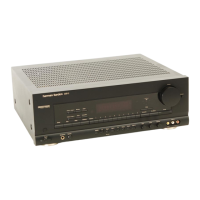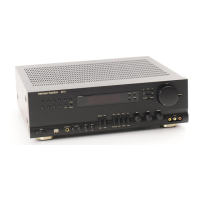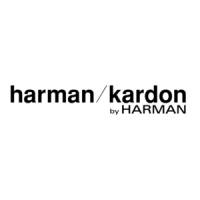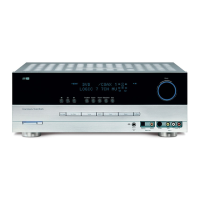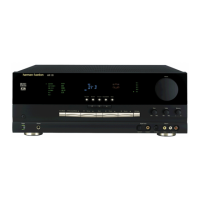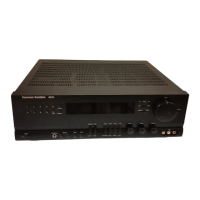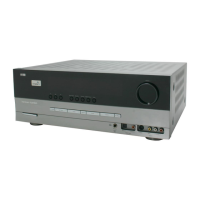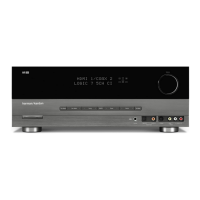Remote
Control
O Use/Learn: This switch selects
the operation mode of the remote
control. Slide it to the left for normal
operation. Slide it to the right when
the remote is being programmed.
f)
Main Power: Press these
buttons to turn the unit
on
or off.
O Source Selection: Pressing one
of these buttons selects the input
source that will be listened to
through the receiver. When a source
is selected the remote's transport
and numeric number buttons will
also transmit the commands needed
to control that machine.
8 Source Power: Press these but-
tons to control power for the last
source device selected.
0 Surround Mode Selection:
Press one of these buttons to select
a surround mode for the current lis-
tening session.
0 Main Volume: These buttons
control the unit's volume. Note that
all channels are controlled simulta-
neously.
Learning
f)
TV
Volume: These buttons
adjust the volume for
TV
using the
remote control codes programmed
into the remote for a
TV
set or cable
box. These buttons control the
TV
set only, regardless of which source
is selected. This enables you to con-
trol the audio level of a
TV
set even
when the receiver is not
in
use.
0 Mute: Press this button to tem-
porarily cut the audio output of the
receiver. Press it again to return to
the previous volume level.
0 Transport Controls: These
buttons control the tape or disc
motion of the last playback source
selected with the Source Selection
buttons
O.
Use them as you would
the
Play,
Stop, Pause, Reverse Play
and Record buttons
on
any
VCR,
CD
or LD remote control.
Cl!>
Tune/Search & Fast Forward:
(These buttons have multiple func-
tions, which vary according
to
the
input device selected.)
a.
When the TUNER has been
selected, these buttons are used
to manually tune stations.
b.
When
CD, LD
or
VCR is the
inpi.Jt
source, these buttons act as
the Fast Scan Forward
~
or
Fast Scan Reverse
~
c0ntrols.
CD
Channel/Skip: (These buttons
have multiple functions, which
vary,
according to the input device
selered.)
a.
W,hen
the TUNER has been
s~.1lected,
these buttons will scroll
u11>
~
or down
~
through
th~
stations that have been pro-
glammed
in
the preset memory.
b.
~hen
TV
or
VCR is selected, they
a(e
the channel up
~
or chan-
nel
down
~
tuning buttons.
c.
When
CD
or
LD is selected these
buttons act as forward and
reverse "Skip" buttons to move to
th.e
next track or chapter on the
disc.
d.
When
a compatible Harman
K~rdon cassette player has been
selected as
Tape 1
or
Tape
2,
t~ese buttons move the tape for-
ward
~
or backwards
~
to the
next selection using the Music
Scan feature.
@ Disc/Deck/Ant: (These buttons
have multiple functions, which
vary according to the input device
selected.)
a.
When
CD
is selected and the unit
is
1
a CD changer, these buttons
will
change to the next disc + or
b.
~~:i:::s:
:·
Tape 2 is the
i17put
source, and the tape
machine is a compatible Harman
Kardon dual cassette deck, these
buttons will switch between the
"A"
and "B" sides.
c.
When
VCR 1
or
VCR 2 is the input
source, these buttons switch
between
VCR
and
TV
as the unit's
output.
d.
When
TV
is the input source,
these buttons may switch
between video input sources or
antenna/video, depending
on
the
TV
model.
e.
When
LD is the input source,
these buttons will switch the side
tfoing played from "A" to "B" on
compatible dual side players.
@),Number Keys: These buttons
serve as a ten button numeric key-
pad to enter tuner preset positions.
They are also to be used to select
channel numbers when
TV
has been
selected
on
the remote, or to select
track numbers on a CD or LD player,
depending on how the remote has
been programmed. The letters
below the buttons are used to enter
information for tuner station names.
NOTE:
The O button has a dual func-
tiorl. It also serves as the
CLEAR
button for use
in
programming the
tuner or clearing the system memory.
$ P-Scan: Press this button to
automatically scan through the sta-
tions preset into the tuner memory.
Press the button again to end the
scan when the tuner stops at the
desired station.
G;, Memo: The memo button is used
to enter stations to the tuner's preset
memory
in
either the manual or auto-
matic modes. It is also used
in
the
process of clearing the memory.
O Delay: This button controls the
amount of sound delay to the rear
(surround) channels. Press it to
increase the delay
in
the steps shown
in
the main Information Display or
on-screen graphics.
4fj
Menu Controls: These buttons
control the action of the cursor or the
selection of menu items when the
receiver is being configured using
the setup menus.
Cl;)
Select: This button enters set-
tings to the receiver's memory dur-
ing system configuration.
4D)
Screen Display: Press this but-
ton to activate the
on
screen menu
system.
@) Panel Display: Press this button
to turn off all displays and indicators
in
the Information Display except for
a small
DI
:S
P indication
in
the
lower right corner of the display
@
Press the button again to turn the
display back on. Note that the dis-
play will briefly illuminate when a
command is sent to the unit from the
front panel or remote, even though
the display is turned off.
9 Test Noise: Press this button to
begin calibration of the output level
for each channel. A test signal will
immediately be heard from the left
front speaker and the
TE
:ST
indica-
tor
@ will flash.
~
Speaker Select: When setting
the system output levels, this button
selects the speaker position being
adjusted. Press it once to advance
to the next speaker after each posi-
tion is adjusted.
@) Level Adjust: When setting the
system output levels, press these
buttons
to
increase or decrease the
output level.
fJ, Sending LED: This indicator
. should flash any time a button is
pressed to confirm that a command
is
being sent to the receiver or anoth-
. er unit.
If
the light is dim or does not
. illuminate when a button
is
pressed
the batteries
in
the remote should be
replaced.
@,
Learn LED: This indicator will
illuminate when a button on the
remote is being programmed with
signals from another remote during
the "learning" mode. The light will go
out when the signal
is
received and
memorized.
fl!) RDS PTY: Press this button to
view the Programme Type informa-
tion for stations transmitting
RDS
data. This button
is
also used for
PTY
Auto Search functions.
@, RDS AF: This button initiates a
search of all
RDS
stations to find a
stronger signal for the programme
type currently selected.
5
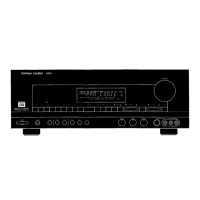
